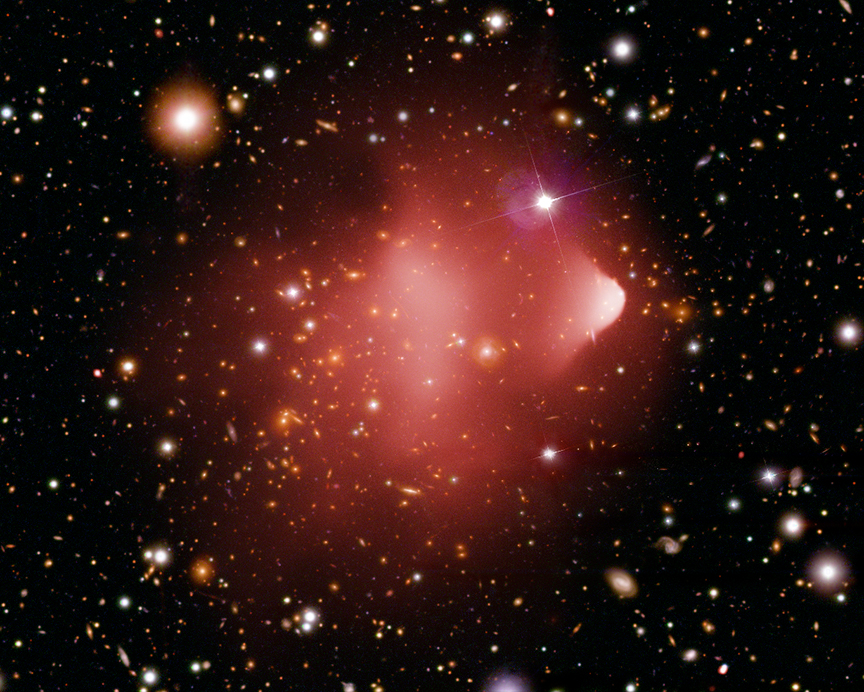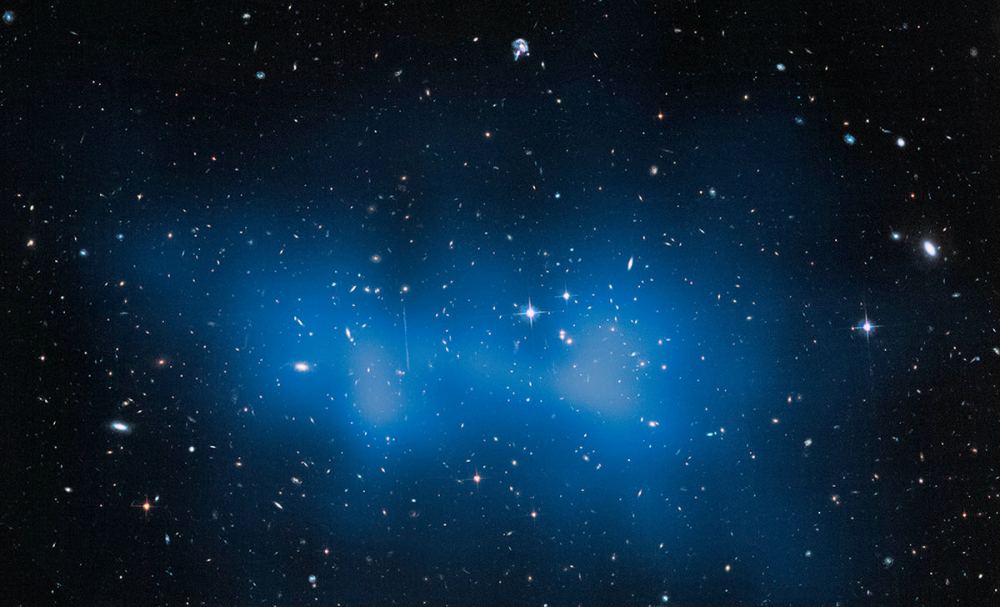Just when cosmologists have a workable theory for when and how galaxy collisions happened in the early Universe, something challenges it. In this case, the challenger is a collision of two massive galaxy clusters that combined to form a gigantic galaxy cluster.
They happened when the Universe was half its age and according to theory, that’s too early. The result of the collision is the El Gordo galaxy cluster. And, its existence challenges the best-accepted theory of cosmology, called the Lambda-cold dark matter (usually abbreviated as LCDM) standard model.
LCDM basically sets constraints (or parameters) on the origin and evolution of structure in the Universe. It has three parts. One is the cosmological constant Lambda (L). It’s associated with dark energy. The second denotes dark matter (labeled CDM). The third is basically ordinary matter (often referred to as “baryonic”). This is a simple way of expressing how the properties of the cosmos that we see came into existence. Essentially, it explains the large-scale structure of the Universe as seen in the Cosmic Microwave Background. It also describes the distribution of galaxies, the abundances of hydrogen, helium, and lithium, and the accelerating expansion of the universe.
So, how does El Gordo and its time-clashing birth process play havoc with LCDM? In that model, galaxies form first in the Universe. Then, later on, they begin to combine to create larger galaxies and clusters of galaxies. That takes time, so having them show up so early—as El Gordo did—in cosmic history is a problem.
Understanding Gigantic Galaxy Cluster Formation
A research team led by Elena Asencio from the University of Bonn, figured out when this collision happened by looking at simulations of the interaction. After detailed analysis, they estimated the mass of the resulting “El Gordo” cluster by using gravitational lensed light from background galaxies. This weak lensing and the mass of the cluster come from Hubble Space Telescope observations and compared with more recent studies by JWST.

The authors then searched through less detailed cosmological LCDM simulations covering a very large volume. They were hunting for simulated cluster pairs. The aim was to count how many of these are broadly analogous to what El Gordo was like shortly before the collision. The team used an innovative “lightcone tomography” method. It considers that more distant objects are viewed further back in time when there was less structure.
The results revealed that the tension with LCDM is very severe for any plausible collision velocity. Moreover, the remaining uncertainty in El Gordo’s mass isn’t as significant. But, there are still other issues to work out. One of them is timing in the early Universe. As mentioned, the collision that produced El Gordo happened too soon. You could make it happen if the collision takes place more quickly. And a simulation shows that. But, while it is possible to get a simulation that looks like El Gordo after the quick collision, such an event is too rare in LCDM. It would be very unusual to find two such massive clusters within striking distance so early in cosmic history. Then, they have to be headed towards each other at a really high speed. That really stretches credibility.
El Gordo and Other Clusters Raise the Tension
The team’s new study and the more precise mass measurement may lead to more efforts to simulate El Gordo to better understand this enigmatic object. That’s because Ascensio and her colleagues were able to get a reliable mass measurement for El Gordo. It actually seems to work better with the LCDM model. However, some issues remain. “This does reduce the tension with LCDM,” said Ascensio, “but it is still highly significant for any plausible collision velocity. Hundreds of detailed simulations show that El Gordo cannot look like the photos with a much slower collision velocity that could plausibly arise in LCDM.”
The “tension” arises because clusters should take longer to form than El Gordo did. And, there are other ones out there that also seem to have formed too quickly, according to LCDM. Dr Indranil Banik of the School of Physics and Astronomy at St Andrews in Scotland, who developed the statistical analysis used in this project, said: “The Bullet Cluster is another example of a highly energetic collision between two galaxy clusters, albeit at a later epoch. Taken in combination with El Gordo, the situation becomes even worse for LCDM. And several other examples are known and mentioned in our study.”
Clusters aren’t the only objects in the early Universe stretching the limits of the LCDM model. Several studies based on JWST results reveal that individual galaxies themselves seem to form more rapidly than the current theory predicts. According to Pavel Kroupa at the University of Bonn and Charles University, this surprisingly faster formation bears watching. “There is now a lot of evidence that structure formation in the Universe occurred faster than expected in LCDM,” he said. “We are currently exploring other lines of evidence for this.”
What’s Next?
With more accurate measurements of El Gordo’s mass and other characteristics, the research team predicts that others will revisit simulations of its formation. One question that will need to be answered is whether or not this massive early collision points to failures in the LCDM mode. As they say in the news business: stay tuned.
For More Information
Titanic Galaxy Cluster Collision in the Early Universe Challenges Standard Cosmology
The El Gordo Galaxy Cluster Challenges LCDM for Any Plausible Collision Velocity
arXiv Preprint


How much of the “tension” we are now seeing is due to the fact that a lot of our models and theories on the evolution of the early universe, are based on assumptions made about the properties of the early universe, that are based on the properties of the modern universe?
To make the claim that there is a statistical tension the authors of the preprint has to do what amounts to p-hacking, fold several handpicked tail observations into a ‘remarkable’ difference. Taking the observations at face value they suggest a 10^-10 likelihood, which is the same likelihood that I exist. Humans have a large population, and it is a huge universe out there.
Putting that aside, these observations and above all their model comparisons which includes problematic star and galaxy simulations are not easy to extract or a clear demonstration that it is purely LCDM that is erroneous. The model results differed a lot more from cosmological observations when they were first made possible to do, so the claims of broken cosmology and/or models may have a long history (which is a trifle I haven’t made an effort to observe).
@Trevor: I doubt there is an easy answer to that.
Some work is put into proposing early universe physics that would better align models with certain observations but of course they have to add additional degrees of freedoms for the fits and so are less likely until there is a robust tension. So far the only remaining significant systematic tension with data is in Hubble rate observations who themselves are in tension and so are not robust.
Other work is on making better observations, as demonstrated by the Hubble telescope. So far it hasn’t discovered anything that breaks LCDM robustly, again the problematic “too large early galaxies” (or in terms of LCDM, having too many baryons) is not robust since improved observation calibration suggest they are not as large as they appear.
The overall trend is that LCDM is ever better tested, so depending on your outlook you can perhaps be fairly satisfied (“been there, seen that”) or dissatisfied (“no exciting new physics”).